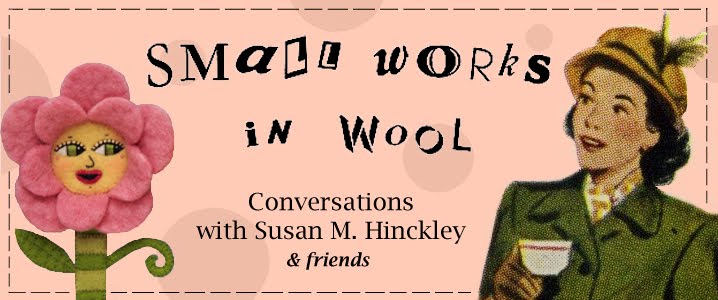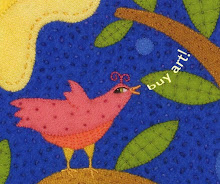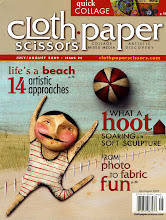But this time I can add something to it, because I've obtained it in the ensuing year and a half. I'm going to put it right here and then you can mentally insert it where you think it should go later:
My sister's first fabric picture
And now, from April 2009:
You never forget your first time . . .
you'd like to forget, but it's still living in your drawer somewhere.
When I first met my mother-in-law, I was certain we didn't have a thing in the world in common. So I decided to take a quilting class, because she is a devoted quilter and I thought it might be a good way to increase our common ground.
She is this kind of quilter:

a true purist -- thousands of hours of experience, opinionated about quilting and very highly skilled, so I knew that I was going to need to confine myself to hand-stitching and traditional patterns and methods.
But that was okay because I was pretty lousy with a sewing machine and also felt I was art-impaired and wouldn't be able to come up with much on my own anyway (I was 18).
The first thing I did was get a "B" on my hand-stitching assignment in class, which didn't make me at all happy because I thought I'd done a splendid job.
It's kind of a miracle that I stayed with it, actually, because I really don't like to do things I'm not good at. It's a character flaw that I truly regret, but can't deny.
Alexander Smith said,
"A great man is the man who does something for the first time."
I'm not sure what that means.
Does it mean that the person who does something for the first time it's ever been done is great? Or does it mean that any person who tries something for the first time is great?
I'm going to vote for the second, because trying things for the first time is quite difficult for me.
There's the possibility of looking like a fool, for one thing.
And the possibility that I'll never be good at it no matter how hard I try, for another.

Like with dancing. Just the way it is.
But despite my embarrassment at not being very good to begin with, I stuck with stitching.
I quickly came to enjoy everything about it: the history, tradition, and connection I felt with other women, the close mentoring relationship with my mother in law, the process, the product. Everything.
After a few years, I took a 10 year folk art detour and left sewing behind. Then one day I came across the work of British applique artist Janet Bolton,
and I was completely mesmerized.
I had missed working with fabric but didn't really miss traditional quilt patterns. Janet Bolton's pictures were something I saw as a divine combination of the narrative style I loved with the process and medium I missed.
My sister (also a maker) and I decided that on our summer vacation, we would try following Janet Bolton's directions to create fabric pictures. This was going to be hard for both of us because of a tendency toward perfectionism, and Janet is a champion (and master!) of the imperfect.
The exquisite, intentional, perfectly imperfect.
And that was exactly what I wanted in my pictures.
We both brought bags of fabric scraps to work with. We decided to try making our designs by cutting directly into the fabric -- no drawing allowed. Sort of like when artists draw with their wrong hand; we thought it might help counter our inclination for exactness.
I chose a chicken because I had made so many of them in my painted wood-and-metal work, I thought I would be able to make a reasonably decent one without much trouble. But I guess that was really trying to hedge my bets against imperfection (read: cheating, and shooting myself in the foot as well), wasn't it?
Anyway, it didn't do much to help me.
Here's that first, funny fabric picture:

You can believe me when I tell you that there were no thunderbolts announcing that I had found my true calling. Lots of laughter with my sister (but also some secret crankiness because hers was so much better than mine!)
Which wasn't really a surprise I guess,
since she's always been better at most craft things than I am

but I thought that by attempting my signature (and popular!) chicken,
I'd be guaranteed at least a little success. Silly silly me.
Oh well, surprisingly, I still got a reward!

No, not a prize, but just a little glimmer of -- something -- that made me want to keep trying.
I revisited the chicken a couple of years ago in homage to that first fabric chicken.
You can see I've had to abandon my quest for Janet Bolton's exquisite imperfection. I tried it for awhile (anyone who owns one of my early pictures can attest to that).
And yes, I still pine for it. But I gotta' be me.
And I guess I like tidy.
W.C. Fields said,
"If at first you don't succeed, try, try again.
Then quit. There's no point in being a damn fool about it."
I hope I've learned that sometimes it's fine looking like a fool for a bit while you're working your way to something worthwhile.
Art = skill.
When you look it up in the dictionary, that's one of the first definitions you see.

But practice doesn't always make perfect.
And perfect doesn't always make art.

It's all a little confusing, isn't it?
So I suppose I'm just going to keep stitching.




















3 comments:
I for one am glad you didn't stop stitching - you found your "voice" so keep on singing!
I am willing to bet that if you spoke with Janet Bolton she would tell you that she has to work very hard to make her pictures perfectly imperfect. I've learned that for a lot of people who make things look intentionally messy, it will usually take them quite a while as well as a lot of work to achieve the "just thrown together" look.
I know that to be true -- for instance, in quilting I find "random" to be the hardest look to achieve, and I find collage to be the hardest medium I work in.
I think imperfection is probably a lot harder than perfection, actually, but I think it takes a particular knack and a ton of skill to pull it off. There's a huge difference between "charmingly naive" and half baked.
Post a Comment